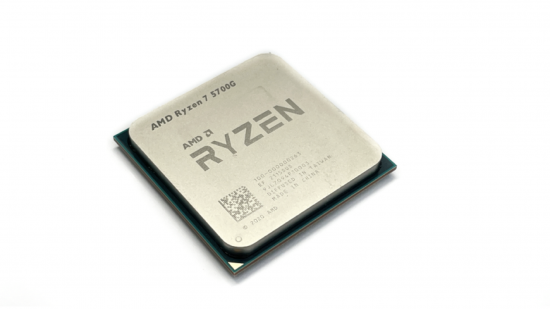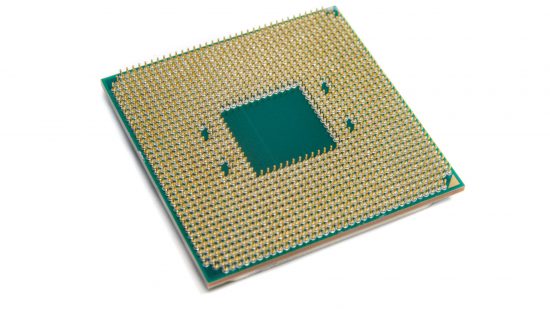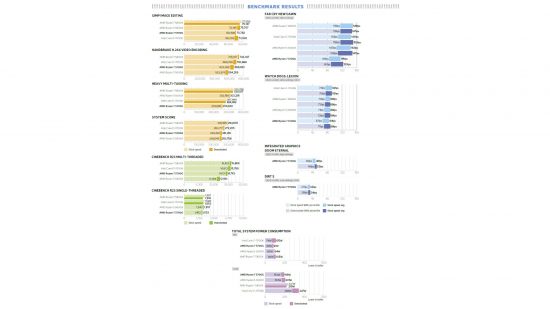Our Verdict
81%It’s not going to beat a GTX 1050 Ti in games, but this is still AMD’s most powerful APU ever.
Ever since AMD introduced its first APUs, we’ve keenly awaited each release as their integrated GPUs usually offer acceptable frame rates at 1080p resolutions and below, saving a lot of cash compared with buying a separate graphics card. They’ve also previously left you with plenty of change from £200, but at £329, the new Ryzen 7 5700G is significantly more expensive.
One reason is that it has eight cores (16 threads) instead of four, although it’s not quite a performance match for the Ryzen 7 5800X. While both chips have eight cores, the latter has double the L3 cache at 32MB, and adds 100MHz to the peak boost speed. We observed an all-core boost clock between 4.2GHz and 4.35GHz on the 5700G, which is also behind the 4.5GHz on the Ryzen 7 5800X at stock speed.
This is mainly because the Ryzen 7 5700G has a TDP of 65W compared to 105W for the 5800X, so it has a lower power limit even before you consider the integrated GPU. It has the same 4MB L2 cache and the same 7nm Zen 3 architecture, but AMD has reined in the spec to reduce its cooling requirements. One benefit, though, is that you comfortably cool it using the included Wraith Stealth cooler. At stock speed, the temperature of the CPU portion of the Ryzen 7 5700G didn’t top 70°C with this cooler, so it’s more than up to the task.
The less welcome news is that AMD hasn’t really upgraded the Radeon RX Vega GPU over the Ryzen 5 3400G. The 5700G has a beefier version of the GPU core, which is now fabricated on a 7nm process, rather than 12nm, but it doesn’t use AMD’s latest RDNA architecture. The Ryzen 7 5700G doesn’t support PCI-E 4 either, so you may as well use it with an older PCI-E 3 motherboard chipset.
Performance
Our image editing test revealed a distinct lack of lightly threaded grunt, with the Ryzen 7 5700G lagging behind both the 5600X and 5800X. However, its eight cores helped in our heavily multi-threaded Handbrake test, where it easily sees off all the 6-core chips, even if it can’t keep up with the Core i7-11700K and Ryzen 7 5800X.
Overall, though, the RealBench tests revealed a CPU that isn’t much faster than the Ryzen 5 5600X and is a fair way off the Ryzen 7 5800X. Cinebench was similar. The Ryzen 7 5700G easily outpaced the 6-core CPUs in the multi-threaded test, but fell behind in the single-threaded test.
The comparatively lacking single-threaded performance has an impact in games too. In Far Cry New Dawn, the 5700G proved to be noticeably slower than most other CPUs at 1080p when using a discrete RTX 3070. In fact, it was only a little quicker than the Ryzen 5 3600.
Switching to the integrated graphics resulted in an impressive 99th percentile frame rate of 40fps at stock speed in Doom Eternal at 1080p with High settings. That’s great for an integrated GPU, although we had to drop Dirt 5 to Low settings for the frame rate to stay above 25fps. This is still a comparatively strong integrated GPU, but it’s a real shame it doesn’t use AMD’s latest RDNA architecture.
Meanwhile, overclocking saw us hit a maximum of 4.5GHz across all cores with a 1.275 vcore, which is lower than the peak boost frequency. Instead, we decided to use Precision Boost Overdrive on the CPU and GPU, which increased the system score from 244,400 to 251,418, and also saw the minimum 99th percentile frame rate rise from 40fps to 45fps in Doom Eternal, although the load power consumption rose from 112W to 187W.
Conclusion
It’s a shame AMD hasn’t moved to its latest GPU architecture with the Ryzen 7 5700G, as it might have allowed for higher settings to be used at 1080p in more demanding titles. Playing Dirt 5 at 1080p with playable frame rates is no mean feat, but we had to turn off most of the eye candy in this relatively easy-to-run game.
We have few complaints with the Zen 3 part of the CPU, which solves the old issue of mediocre CPU performance in AMD’s APUs. However, it’s swung so far in this direction that the GPU is now noticeably lacking. That said, AMD has no real competition here, and if you want an affordable 8-core CPU for content creation, along with a bit of gaming power, but you can’t afford a discrete GPU, the AMD Ryzen 7 5700G offers unbeatable performance as a whole.
Price
£320
Scores
PERFORMANCE: 34/50 | FEATURES: 15/15 | VALUE: 32/35
Pros
- Fastest APU ever
- Excellent multi-threaded performance
- Reasonable integrated GPU
Cons
- No PCI-E 4 support
- Aging Vega GPU holds back gaming
- Cheaper CPUs are faster in some tests
AMD Ryzen 7 5700G specifications
- Base frequency: 3.8GHz
- Max boost frequency: 4.6GHz
- Core: Zen 3
- GPU core: Radeon RX Vega 8
- Manufacturing process: 7nm
- Number of cores: 8 x physical (16 threads)
- Cache: 16MB L3 cache, 4MB L2 cache
- Memory controller: Dual-channel DDR4, up to 3200MHz
- Packaging: Socket AM4
- Thermal design power (TDP): 65W
- Features: Simultaneous Multithreading, Precision Boost 2, Precision Boost Overdrive 2, FMA3, F16C, SHA, BMI / BMI1 + BMI2, AVX2, AVX, AES, SSE4a, SSE4, SSSE3, SSE3, SSE2, SSE



